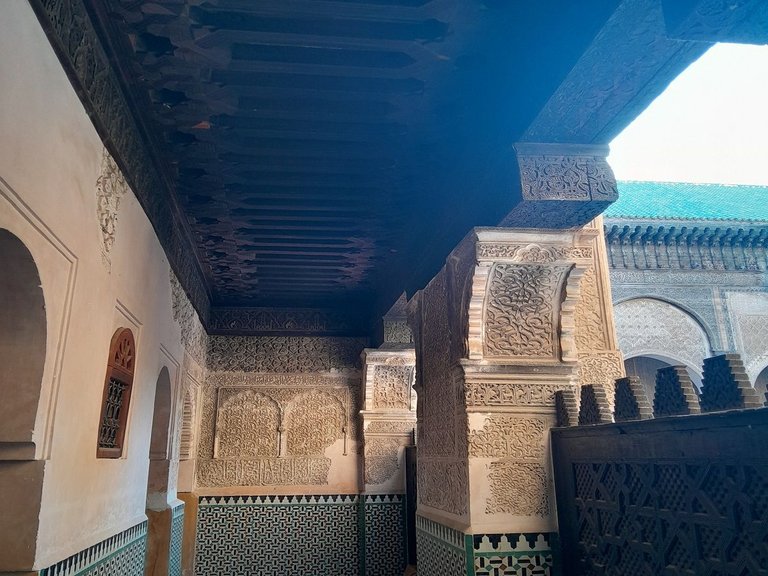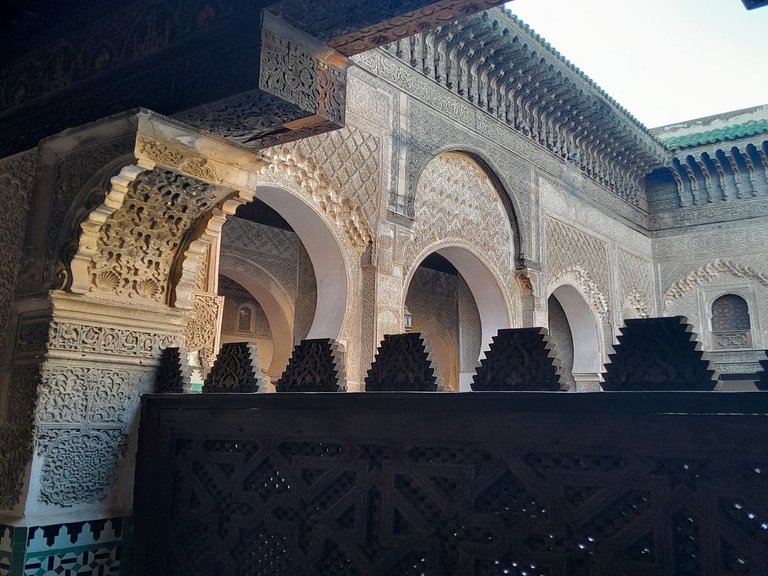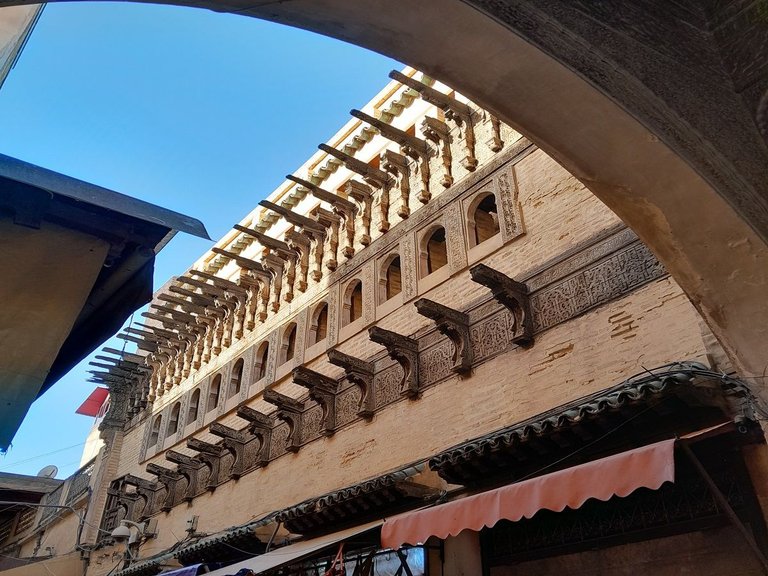Hello everyone!
The city of Fes is considered one of the best tourist destinations in the world to visit, according to tourism and travel websites, thanks to its historical and tourist importance.
In this article, I'll be taking you on a tour of one of Morocco's most magnificent, impressive and unusual ancient schools: Bou-Inania, located in the heart of the medina (ancient city) of Morocco's spiritual capital, Fes. It's not far from the historic Bab Boujloud gate, which is the main entrance to the medina!



What really impressed me was the large number of tourists and visitors I found in the main hall of this school. Everyone seemed to be in awe of the architecture and the geometric shapes of the building. Everyone was taking photos, which sometimes meant that I had to wait a while in each corner before I could capture an image. But to be honest, this influx of visitors from all over the world gave the visit a special flavour and added even more charm and fascination to this exceptional place!

Here I am inside the hall of one of the wonders of Merinid civilisation (the Merinids, a Berber dynasty, reigned from 1244 to 1465 and left their mark on their era through their cultural and architectural refinement. Their capital, Fes, was a veritable jewel where they founded the famous Bou-Inania school).
The man who founded this famous school attached great importance to knowledge and worked to train scholars, placing the main emphasis on teaching as a basis for tackling the secular sciences needed by humanity. Here, students came to learn according to a rigorous and profound educational system, designed to prepare scholars for this nation.










The Marinids left nothing to chance: they inscribed the history of its construction on the walls, so that it would be preserved intact for future generations. If you read the inscriptions on the walls, you'll find phrases confirming that the school was built during the 14th century.
The education system was based on curricula, rather than a fixed number of years. If students were able to memorise lessons quickly and seriously, they could complete their studies quickly. If their ability was more modest, they could spend more years. Education in the Marinid schools took place in several stages: first, basic training, then specialisation in fields such as religion, law, medicine or engineering. The aim was to train qualified and specialised people.
The Marinid civilisation not only valued knowledge, it also paid particular attention to the aesthetics of its buildings. Students studied in splendid surroundings, with refined decorations, elegant motifs and highly creative Arabic calligraphy. At the centre of the courtyard is a pool that some students still use for ablutions. Students would follow study circles around the fountain, not just in the classrooms or the mosque.








The Bou-Inania school contains numerous inscriptions and ornaments that embellish its walls. These inscriptions bear profound religious and literary messages, written in Andalusian and Kufic calligraphy. Examples of the engraved phrases that can be found here include:
‘وما توفيقي إلا بالله عليه توكلت وإليه أنيب": This phrase expresses total trust in God in all matters.
‘إنما يخشى الله من عباده العلماء’ : Indicates the value of knowledge and scholars in Islam.
‘وقل رب زدني علما’ : A prayer to ask for more knowledge, in keeping with the educational vocation of the medersa.
‘العلم نور يهدي السبيل’ : Emphasises the value of science and its role in guidance.

Merinid architecture combines elegance, beauty and functionality. It uses marble, Moroccan zelliges and sculpted plaster, with a touch of Andalusia visible on the upper floors. This architecture symbolises the cultural fusion between Morocco and Andalusia.
After taking the photos in the main hall, I went inside for a tour of the corridors:










Just outside the school and at the top of the main door is a hydraulic clock. Similar to the clock in the Alhambra Palace in Granada, known as the Lion Clock. The Fes clock system is based on copper balls that fall at precise intervals to indicate the hours.

Look what we have here. We have windows. If you count them, you'll find 12 windows, corresponding to the 12 hours. This structure was linked to the operation of the hydraulic clock.
The water came in, rose and set a mechanism in motion. It was a mechanical and hydraulic clock, powered by the force of water. When the time changed, for example at 5 or 6 o'clock, two mechanical birds came out to strike a sound signal. If it was 4 o'clock, they would strike 4 times, letting people know the exact time.
In addition, under the wooden structures, there was a system where a metal bell fell on a surface, producing a sound that could be heard from a distance. So even those who couldn't see the clock could tell the time by the sound.
Look at how, at the time, we were interested in knowledge, progress and scientific details. The ruler, thanks to his interest in knowledge and time, ordered the construction of this clock so that students and pupils could tell the time accurately.



This exceptional monument embodies the ingenuity and remarkable skills of Moroccan craftsmen of the time, who combined tradition and creativity to create a work of such magnificence. Today, it remains a shining symbol of Fes' cultural heritage and a source of pride for its inhabitants, testifying to the city's rich and timeless heritage.
Thank you for taking the time to read this article. I sincerely hope you enjoyed my photos and that they inspire you to explore this exceptional place. Share your thoughts in the comments, I'd love to hear from you! See you soon for new escapades and fascinating discoveries!

I'm Redwan from Morocco, a country rich in history, culture and natural landscapes! I've always had a passion for travelling and discovery. Nothing gives me greater pleasure than exploring new places, whether historical, archaeological or in the heart of nature. Through my blogs, you can discover the hidden gems of Morocco, whether you want to admire the fascinating architecture of a historic site, delve into the legends surrounding an archaeological site, or simply marvel at the beauty of Moroccan nature!
Photos taken by my own phone (Samsung Galaxy A04s).

Beautiful mosaic in this Fabolous architecture
Thank you so much for your kind comment!
Another great post from Marocco! Remarkable the buildings and Mosaics all over them!
Thank you very much @lizanomadsoul ! Your words make me happy and motivate me even more 😍
That is great to hear @hierundjetzt. My pleasure 😘 - Congrats on your new tickets for the winterchallenge as well. You are on fire!
wow, every calligraphy in that place is really beautiful!
Thank you so much! 😊 I totally agree with you, the calligraphy in this place is really fascinating and shows incredible craftsmanship!
Hiya, @ybanezkim26 here, just swinging by to let you know that this post made it into our Top 3 in Travel Digest #2403.
Your post has been manually curated by the @worldmappin team. If you like what we're doing, please drop by to check out all the rest of today's great posts and consider supporting other authors like yourself and us so we can keep the project going!
Become part of our travel community:
This post has been manually curated by @steemflow from Indiaunited community. Join us on our Discord Server.
Do you know that you can earn a passive income by delegating to @indiaunited. We share more than 100 % of the curation rewards with the delegators in the form of IUC tokens. HP delegators and IUC token holders also get upto 20% additional vote weight.
Here are some handy links for delegations: 100HP, 250HP, 500HP, 1000HP.
100% of the rewards from this comment goes to the curator for their manual curation efforts. Please encourage the curator @steemflow by upvoting this comment and support the community by voting the posts made by @indiaunited.
You can check out this post and your own profile on the map. Be part of the Worldmappin Community and join our Discord Channel to get in touch with other travelers, ask questions or just be updated on our latest features.